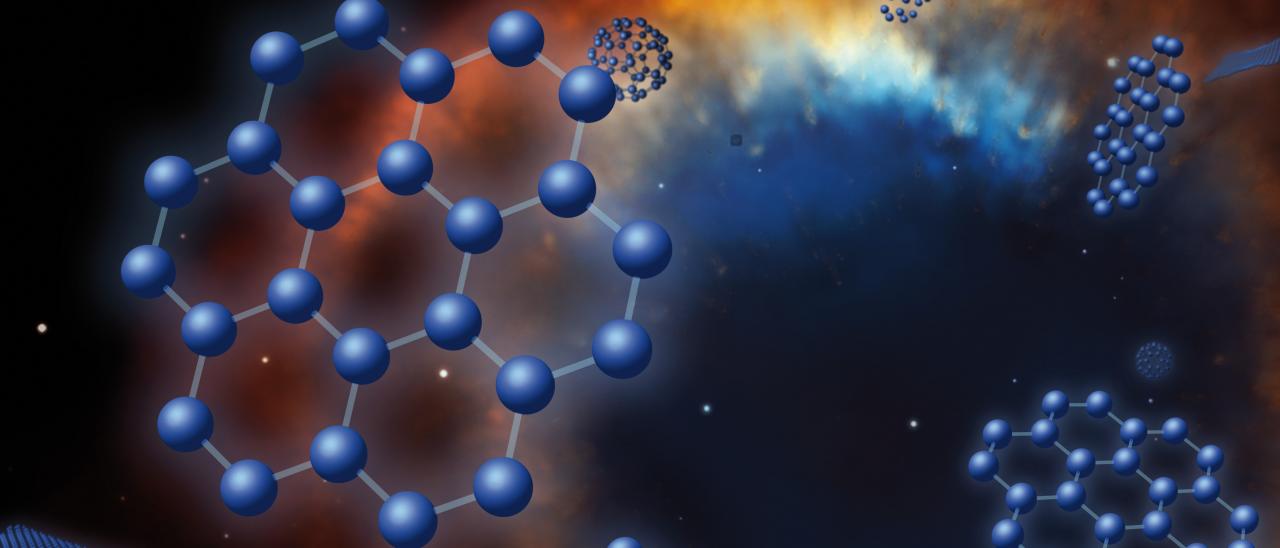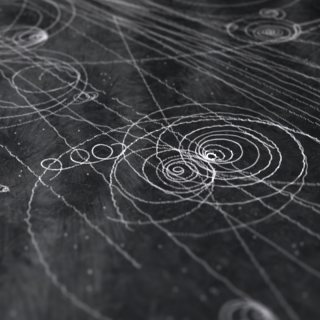Grants related:
General
Low- to intermediate-mass (M < 8 solar masses, Ms) stars represent the majority of stars in the Cosmos. They finish their lives on the Asymptotic Giant Branch (AGB) - just before they form planetary nebulae (PNe) - where they experience complex nucleosynthetic and molecular processes. AGB stars are important contributors to the enrichment of the interstellar medium where new stars/planets are born (including our own Early Solar System, ESS), and to the chemical evolution of stellar systems like globular clusters (GCs) and galaxies. In particular, the more massive (M > 4-5 Ms) AGB stars synthesize very different (radio)isotopes from those formed by lower mass AGB stars and Supernova detonations, as a consequence of different nucleosynthesis mechanisms. Evolved stars in the transition phase between AGB stars and PNe also form diverse organic compounds like PAHs, and fullerene and graphene molecular nanostructures, being a wonderful laboratory for Astrochemistry. On-going massive surveys like SDSS-IV/APOGEE-2 and the upcoming James Webb Space Telescope (JWST) represent a fundamental step forward to understand the nucleosynthesis and molecular processes in evolved stars. We aim to explore the nucleosynthesis of light and heavy (radio)isotopes in AGB stars and how they contribute to the ESS radioactive inventory as well as to the formation and evolution of GCs and galaxies. We also aim at understanding the top-down formation process of fullerene and graphene molecular nanostructures in evolved stars. Finally, it is intended to perform data mining with the Gaia satellite, in order to study the AGB- PNe evolutionary phase. In addition we aim to use the GALEX database to discover binary central stars in Galactic PNe.
Members
Results
1. During 2020, we have published 37 papers in high-impact international refereed astronomical journals (including one invited review) and 2 papers in the Chemistry -Physics journal FNCN.
2. Phosphorus-rich stars with an extremely peculiar chemical abundance pattern have been discovered for the first time, challenging the theoretical nucleosynthesis predictions.
3. It was demonstrated that the P-rich star progenitors represent a new site for s-process nucleosynthesis, with important implications for the chemical evolution of our Galaxy.
Scientific activity
Related publications
-
EPOXI: Comet 103P/Hartley 2 Observations from a Worldwide Campaign
Earth- and space-based observations provide synergistic information for space mission encounters by providing data over longer timescales, at different wavelengths and using techniques that are impossible with an in situ flyby. We report here such observations in support of the EPOXI spacecraft flyby of comet 103P/Hartley 2. The nucleus is small
Meech, K. J. et al.Advertised on:
62011 -
UV photolysis of polyynes at λ=254 nm and at λ>222 nm
Not Available
Cataldo, Franco et al.Advertised on:
62008 -
The Chemical Composition of Cernis 52 (BD+31° 640)
We present an abundance analysis of the star Cernis 52 in whose spectrum we recently reported the naphthalene cation in absorption at 6707.4 Å. This star is on a line of sight to the Perseus molecular complex. The analysis of high-resolution spectra using a χ2-minimization procedure and a grid of synthetic spectra provides the stellar parameters
González Hernández, J. I. et al.Advertised on:
112009 -
Stability of C60 and C70 fullerenes toward corpuscular and γ radiation
The stability of C60 and C70 fullerenes in the interstellar medium deposited on dust surface or embedded in meteorites and comets has been simulated with γ irradiation and with He+ ion bombardment. It is shown by vibrational spectroscopy that a γ radiation dose of 2.6MGy (1Gy = 1 joule absorbed energy per kilogram) causes partial oligomerization of
Cataldo, Franco et al.Advertised on:
42009 -
Solid state radiolysis of amino acids in an astrochemical perspective
The aliphatic amino acids L-alanine and L-leucine and the aromatic amino acids L-phenylalanine, L-tyrosine and L-tryptophan were irradiated in the solid state to a dose of 3.2 MGy. The degree of decomposition was measured by differential scanning calorimetry (DSC). Furthermore the degree of radioracemization was measured by optical rotatory
Cataldo, Franco et al.Advertised on:
12011 -
On the action of UV photons on hydrogenated fulleranes C60H36 and C60D36
Fulleranes, the hydrogenated fullerenes C60H36 and C60D36 have been synthesized in n-hexane where they show an absorption maximum at 217 nm in their electronic absorption spectra with molar extinction coefficients ɛ217 = 17140 and 16480L cm-1 mol-1, respectively, which correspond to absorption cross-sections of order 6500 Mbarn, about 10 times
Cataldo, Franco et al.Advertised on:
112009 -
Infrared spectroscopy of hydrogenated fullerenes (fulleranes) at extreme temperatures
The infrared spectra, as well as the integrated molar absorptivity (Ψ) and the molar extinction coefficient (ɛ) of each infrared transition of the hydrogenated fullerenes (known as fulleranes) C60H36, C60H18 and C70H38, and a mixture of fulleranes generally referred to as 77 per cent of C60Hx and 22 per cent C70Hy with x≈y > 30, are presented and
Iglesias-Groth, S. et al.Advertised on:
72012 -
Infrared spectroscopy and integrated molar absorptivity of C60 and C70 fullerenes at extreme temperatures
The detection of C60 and C70 fullerenes in young planetary nebulae and in reflection nebulae suggests that these molecules are more common in certain astrophysical environments than previously thought. The dependence on temperature of the positions and widths of the infrared bands of the C60 and C70 fullerenes is needed for a firm qualitative
Iglesias-Groth, S. et al.Advertised on:
52011 -
Evidence for the Naphthalene Cation in a Region of the Interstellar Medium with Anomalous Microwave Emission
We report high-resolution spectroscopy of the moderately reddened (AV=3) early-type star Cernis 52 located in a region of the Perseus molecular cloud complex with anomalous microwave emission. In addition to the presence of the most common diffuse interstellar bands (DIBs) we detect two new interstellar or circumstellar bands coincident to within 0
Iglesias-Groth, S. et al.Advertised on:
92008 -
Amino acids in comets and meteorites: stability under gamma radiation and preservation of the enantiomeric excess
Amino acids in Solar system bodies may have played a key role in the chemistry that led to the origin of life on Earth. We present laboratory studies testing the stability of amino acids against high energy radiation. All the 20 chiral amino acids in the levo form found in the proteins of the current terrestrial biochemistry were irradiated in the
Iglesias-Groth, S. et al.Advertised on:
12011 -
A search for naphthalene in diffuse interstellar clouds
We have obtained high-resolution optical spectroscopy of 10 reddened O-type stars with Ultraviolet and Visual Echelle Spectrograph at Very Large Telescope to search for interstellar bands of the naphthalene cation (C10H8+) in the intervening clouds. No absorption features were detected near the laboratory strongest band of this cation at 6707 Å
Iglesias-Groth, S. et al.Advertised on:
32012 -
A search for interstellar anthracene towards the Perseus anomalous microwave emission region
We report the discovery of a new broad interstellar (or circumstellar) band at 7088.8 +/- 2.0 Å coincident to within the measurement uncertainties with the strongest band of the anthracene cation (C14H10+) as measured in gas-phase laboratory spectroscopy at low temperatures. The band is detected in the line of sight of star Cernis 52, a likely
Iglesias-Groth, S. et al.Advertised on:
102010 -
A photometric redshift of z = 1.8{+0.4}{-0.3} for the AGILE GRB 080514B
The AGILE gamma-ray burst GRB 080514B is the first detected to have emission above 30 MeV and an optical afterglow. However, no spectroscopic redshift for this burst is known. We report on our ground-based optical/NIR and millimeter follow-up observations of this event at several observatories, including the multi-channel imager GROND on La Silla
Rossi, A. et al.Advertised on:
112008 -
The Formation of Fullerenes: Clues from New C60, C70, and (Possible) Planar C24 Detections in Magellanic Cloud Planetary Nebulae
We present 10 new Spitzer detections of fullerenes in Magellanic Cloud Planetary Nebulae, including the first extragalactic detections of the C70 molecule. These new fullerene detections together with the most recent laboratory data permit us to report an accurate determination of the C60 and C70 abundances in space. Also, we report evidence for
García-Hernández, D. A. et al.Advertised on:
82011



